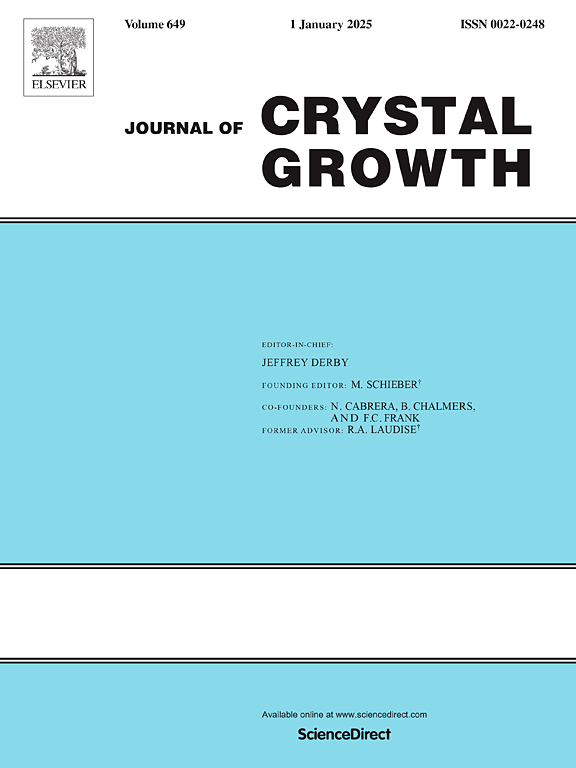内坩埚结构对硅晶体连续进料直拉生长中氧输运和分布的影响
IF 1.7
4区 材料科学
Q3 CRYSTALLOGRAPHY
引用次数: 0
摘要
氧是硅晶体中重要的杂质之一。过量的氧气会导致太阳能电池缺陷的增加和效率的降低。因此,降低氧浓度是硅晶体研究的关键问题。在本研究中,考虑到内坩埚角部和底部的复杂形状,而不是采用柱面划分的简化方法,建立了连续进料奇克拉尔斯基硅晶体生长的全局二维模型。在此基础上,通过数值模拟研究了坩埚内径、炉角形状和炉底形状对流动、传热和氧输运的影响。结果表明,内坩埚的结构对氧输运有显著影响。随着坩埚内径的减小,结晶界面处的氧含量增加;随着坩埚内角曲率半径的增大,结晶界面处的氧含量减少;随着坩埚内底曲率半径的增大,结晶界面处的氧含量增加。研究结果可为降低氧浓度的内坩埚结构优化提供指导。本文章由计算机程序翻译,如有差异,请以英文原文为准。
Effect of inner crucible structure on oxygen transport and distribution in the continuous-feeding Czochralski growth of silicon crystal
Oxygen is one of the critical impurities in silicon crystal. Excessive oxygen leads to increased defects and reduced efficiency of solar cells. Therefore, reducing oxygen concentration is a key issue in silicon crystal. In this study, a global 2D model for the continuous-feeding Czochralski silicon crystal growth was established, considering the complex shapes of the corner and bottom of inner crucible, instead of using the simplification of cylindrical partition. Based on the model, numerical simulations were performed to investigate the effects of inner crucible diameter, corner shape, and bottom shape on flow, heat transfer and oxygen transport. The results indicate that the structure of inner crucible significantly affects the oxygen transport. With the decrease of inner crucible diameter, the oxygen at crystallization interface increases; with the increase of curvature radius of inner crucible corner, the oxygen at crystallization interface decreases; with the increase of curvature radius of inner crucible bottom, the oxygen at crystallization interface increases. The findings can provide guidance for the optimization of inner crucible structure for reducing oxygen concentration.
求助全文
通过发布文献求助,成功后即可免费获取论文全文。
去求助
来源期刊

Journal of Crystal Growth
化学-晶体学
CiteScore
3.60
自引率
11.10%
发文量
373
审稿时长
65 days
期刊介绍:
The journal offers a common reference and publication source for workers engaged in research on the experimental and theoretical aspects of crystal growth and its applications, e.g. in devices. Experimental and theoretical contributions are published in the following fields: theory of nucleation and growth, molecular kinetics and transport phenomena, crystallization in viscous media such as polymers and glasses; crystal growth of metals, minerals, semiconductors, superconductors, magnetics, inorganic, organic and biological substances in bulk or as thin films; molecular beam epitaxy, chemical vapor deposition, growth of III-V and II-VI and other semiconductors; characterization of single crystals by physical and chemical methods; apparatus, instrumentation and techniques for crystal growth, and purification methods; multilayer heterostructures and their characterisation with an emphasis on crystal growth and epitaxial aspects of electronic materials. A special feature of the journal is the periodic inclusion of proceedings of symposia and conferences on relevant aspects of crystal growth.
 求助内容:
求助内容: 应助结果提醒方式:
应助结果提醒方式:


